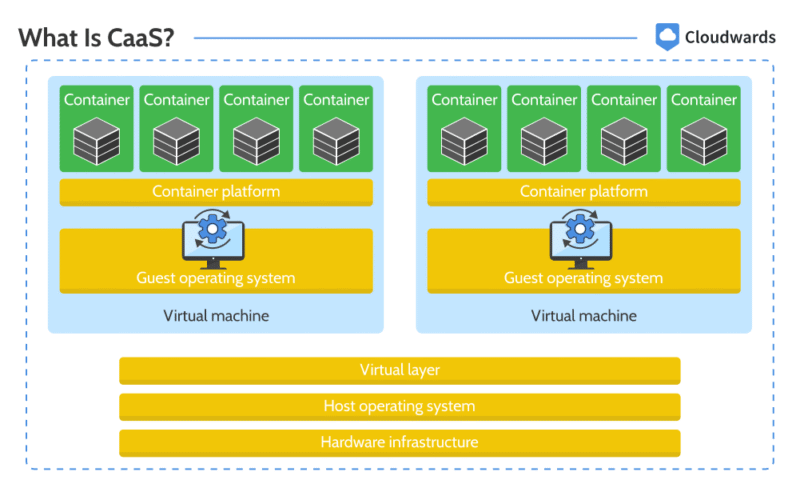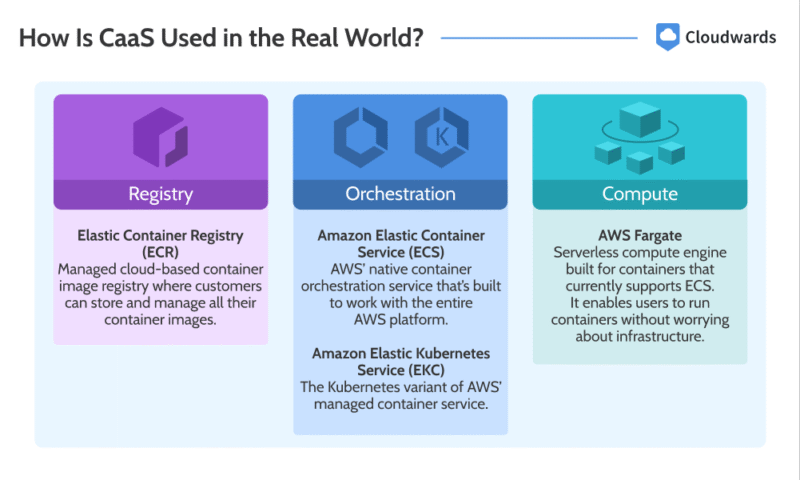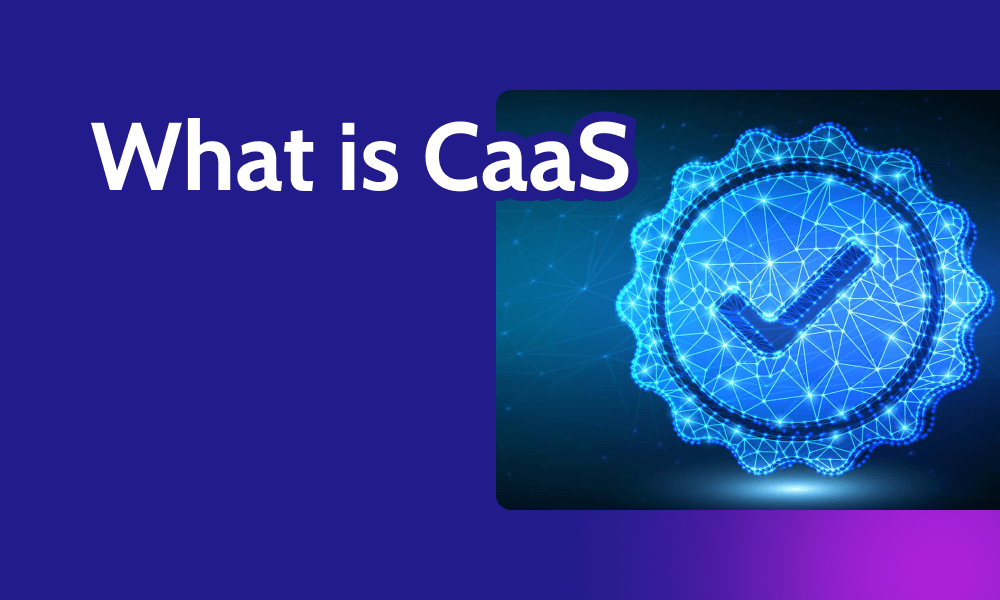Container as a Service (CaaS) is a cloud delivery model designed for containerization, enabling software portability across different deployment environments while also enhancing elasticity through automated scaling features.
This guide takes you through the details of the Container-as-a-Service model as offered by cloud computing platforms, discussing its benefits and challenges, as well as some examples of how it works. We also compare CaaS to other delivery models, highlighting the differences in how they are managed.
What Is CaaS? Meaning Explained
CaaS stands for “Container as a Service.” This cloud delivery model offers a platform for deploying and managing containers without having to manage the underlying infrastructure.
Containers are packages made up of software and the resources needed to run that software (like a library and its own operating system). The CaaS model offers a pre-configured environment where you can run these packages, leaving you with less work and more time to focus on optimizing your application.

With CaaS, multiple containerized applications can run on one machine at the same time.
How Does CaaS Work?
In the CaaS model, you deploy a containerized application and its data on your preferred CaaS solution. You can choose the container runtime, but you never have to worry about managing the underlying operating system, server or virtualization technology.
In some cases, the CaaS provider may offer a platform on which you can containerize your application, if you haven’t done so already.
CaaS is similar to PaaS (Platform as a Service) in that you manage the application and data, and choose a runtime. However, in CaaS, you package your application in a way that makes it runnable on various platforms, while in PaaS, your application is less portable.
Key Components of CaaS
Perhaps the most important building block of a CaaS offering is the container runtime, since that’s what makes containers run on the host server. However, other key components, such as container orchestration tools, container registry, storage and networking, also play crucial roles.
- Container orchestration tool: These tools run the show in CaaS solutions; they automate various processes, including container deployment, scaling and management.
- Container runtime: The container runtime creates the environment in which containers run. It acts as a medium through which containers use host system resources and manages the resources.
- Container registry: A container registry is a repository for storing and distributing container images, which are templates that contain the specifications for creating containerized applications.
- Host server: The host server is the machine where the containers are deployed. It offers the computing resources that the containers run and is managed by the cloud provider.
- Storage: By default, data written to containers is not persistent; in other words, when a container goes offline or is destroyed, the data stored on it is lost. For this reason, CaaS providers offer persistent storage for critical data, which ensures the data is safe from deletion even if the containers are destroyed.
- Networking: A CaaS solution’s networking system drives the communication between containers, services and external environments. It includes features like load balancing and service discovery. Without networking, there is no coordination between the containers and services, and your application becomes inaccessible.
Is CaaS Different From Kubernetes?
Yes, CaaS is different from Kubernetes. Though Kubernetes is typically used in CaaS solutions, they are not the same.
CaaS is a cloud delivery model that provides a pre-configured environment for containerized applications, while Kubernetes is a software framework used to automate container deployment, management and scaling. Learn more in our Kubernetes vs Docker guide.
Benefits of CaaS
Containers are designed for portability, so it should come as no surprise that CaaS builds on this as one of its top benefits, among others. CaaS solutions can be beneficial in the following ways:
- Portability: Since containerized applications are pre-packaged with the dependencies they need to work the same way everywhere, you can readily deploy your containerized application on CaaS solutions from different providers.
- Resource efficiency: Unlike traditional virtual machine deployments, CaaS platforms allow you to deploy multiple containerized applications on a single host system, helping you make the most out of your resources.
- Focused app development: With the CaaS model, software development teams do not need to worry about provisioning and managing the underlying compute resources. All they have to focus on is writing quality code and containerizing their applications.
- Microservices architecture: When using a CaaS platform, you can split your application into multiple functional containerized units, creating a microservices architecture. With a microservices architecture, you benefit from increased fault tolerance and better agility.
Challenges of CaaS
The challenges of CaaS include data transience, integration issues and complex management. We describe these challenges in more detail below:
- Integration issues: It’s not unusual to find that you cannot directly integrate older systems with CaaS solutions. In such cases, you’ll have to replace some tools on the older system, and you may even have to refactor your application’s code to make it suitable for the CaaS solution’s microservices architecture.
- Complex management: Though CaaS systems remove the responsibility of managing the underlying infrastructure, configuring and managing CaaS can be complex, especially when working with large container clusters. You have to set up and troubleshoot networking, monitoring, logging and storage, which requires skills.
- Data transience: Containers are stateless by default, so any data you store on them is lost when the container is restarted or destroyed. For this reason, if you’re looking to use CaaS for critical applications, you’ll have to set up external persistent storage to ensure easy recovery.
How Is CaaS Used in the Real World?
Tempus EX and CMC Markets use CaaS tools like Amazon Elastic Container Service (ECS) for hybrid deployments, as it allows applications to run the same way on-premises and in the cloud.
Aside from hybrid deployments, CaaS solutions are commonly used for setting up continuous integration and continuous deployment pipelines (CI/CD).
Since they are highly automated, CaaS tools integrate smoothly with other automation tools in CI/CD pipelines to ensure rapid testing, security scanning, quality scanning, monitoring and deployment. For instance, Manulife uses Azure Kubernetes Service in its pipelines for fast development.
CaaS is also commonly used for batch jobs. For example, instead of having long-running servers execute short-lived processes, Affirm uses ECS to spin up containers to run those processes.

Elastic Container Service is AWS’ proprietary container orchestration offering.
Examples of Container Platform Services
Many of the major cloud service providers offer managed Kubernetes services as part of their CaaS catalog.
You’ll find Elastic Kubernetes Service on Amazon Web Services (AWS), while Microsoft Azure offers Azure Kubernetes Service and Google Cloud has Google Kubernetes Engine. Oracle Cloud Infrastructure and Alibaba Cloud offer OCI Kubernetes Engine and Container Service for Kubernetes, respectively.
In addition to managed Kubernetes services, cloud providers offer other CaaS solutions, including Amazon Elastic Container Service, Elastic Container Registry, Microsoft Azure Container Instances, Web App for Containers, Google Cloud Container Builder and IBM Container Registry.
CaaS vs Other Cloud Computing Delivery Models
We briefly compared CaaS with PaaS earlier. We’ll now compare it with other cloud delivery models, including PaaS, SaaS and IaaS.
Final Thoughts
By offering access to an environment designed to run containers, CaaS solutions allow developers to focus more on software development and containerization. They also offer flexibility, portability and resource efficiency, and they improve fault tolerance when you adopt a microservices architecture.
In your opinion, how transformative has the CaaS model been for cloud computing? Which CaaS solution is the most valuable in your everyday experience? If you were to switch from your current CaaS provider to another provider, which factors would determine your choice? Let us know what you think in the comments. Thank you for reading.
FAQ: CaaS Cloud Service
-
CaaS stands for “Container as a Service,” which is a cloud delivery model that offers a predesigned environment for running and managing containers.
-
Examples of CaaS include Elastic Kubernetes Service, Google Kubernetes Engine and Google Cloud Run.









